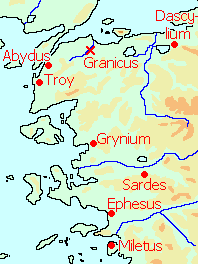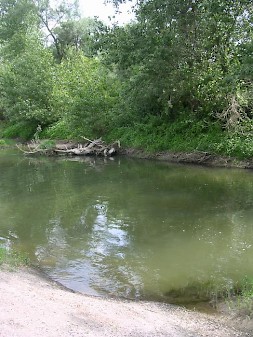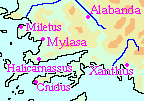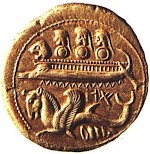Memnon of Rhodes
Memnon of Rhodes (c.380-333): Greek mercenary leader in Persian service, adversary of Alexander the Great.

Memnon's career in Persian service had a strange start. In fact, the Persians needed his brother Mentor to defend the Troad (the northwest of modern Turkey), and gave him land in that region. Not much later, Mentor was made Persian supreme commander in the West and married Barsine, the daughter of the satrap of Hellespontine Phrygia, Artabazus, who married a sister of the Rhodians.
Memnon joined his brother and shared in his adventures. For example, when Artabazus rebelled against king Artaxerxes III Ochus in 353 or 352, they assisted him. The revolt was not successful, and Artabazus and Memnon were forced to flee to Pella, the capital of Macedonia. Here, they met king Philip, the young crown prince and the philosopher Aristotle of Stagira.
Mentor managed to receive a pardon. In 343, he played an important role in the Persian reconquest of Egypt, which had been independent for some sixty years. When Artaxerxes asked him how he could express his gratitude, Mentor asked for the recall of Memnon, Artabazus and his wife Barsine. The king pardoned the former rebels and received invaluable information about the plans of Philip to attack Persia as soon as he had subdued the Greek cities.
Mentor died in 340 and Memnon inherited his land in the Troad. He married Barsine - it was his second marriage - and expected to be appointed supreme commander in the West, but neither Artaxerxes III, nor Artaxerxes IV (338-336) nor Darius III Codomannus (336-330) dared to give the former rebel this prestigious job. Perhaps this was a decisive mistake: Memnon could have stopped the expedition of Alexander.
In 336, the Macedonians attacked. Their vanguard was commanded by Parmenion, the only general trusted by king Philip. He proved to be no match for Memnon, who defeated Parmenion at Magnesia and was able to isolate him in the northwest of modern Turkey. In the words of Diodorus of Sicily:
Darius [III] took warning and began to pay serious attention to his forces. He fitted out a large number of ships of war and assembled numerous strong armies, choosing at the same time his best commanders, among whom was Memnon of Rhodes, outstanding in courage and strategic grasp. The king gave him 5,000 mercenaries and ordered him to march toCyzicus and to try to get possession of it. With this force, accordingly, Memnon marched on across the range of Mount Ida. [....]
Memnon, suddenly falling upon the city of Cyzicus, came within an ace of taking it. Failing in this, he wasted its territory and collected much booty. While he was thus occupied, Parmenion took by storm the city of Grynium and sold its inhabitants as slaves, but when he besieged Pitanê, Memnon appeared and frightened the Macedonians into breaking off the siege. Later Calas with a mixed force of Macedonians and mercenaries joined battle in the Troad against a much larger force of Persians and, finding himself inferior, fell back on the promontory of Rhoeteium.note
In other words, Memnon pushed back the invaders to the northwest of Asia Minor. His success may be partially explained from the fact that Philip had been succeeded by Alexander, who needed the year 335 to restore order in his territories and was unable to send reinforcements to Parmenion.

In 334, Alexander joined his general. From now on, the Macedonians were in numbers superior to the Persians. The Persian leaders discussed their strategy: Memnon proposed to use the Persian navy to attack the Macedonians at home, and to avoid battle in Asia, where they ought to destroy all crops, horse feed and towns. This would force Alexander, who was short of supplies, to return. Memnon's proposal was probably the best idea, but the other commanders agreed that it was better to fight.
The Persians dug themselves in on the banks of the river Granicus, the modern Biga Çay. If Alexander moved to the south, where he wanted to liberate Greek towns like Ephesus and Miletus, they could attack his rear; if he moved to the east to drive them out, their position was strong enough to withstand the attack of a larger army. However, the Persians were defeated (June 334).

Darius, however, understood that Memnon had been right about his strategy. He ordered the Persian navy to move to the Aegean sea; it had to come from Egypt, Phoenicia, and Cyprus, and it arrived three days too late to prevent the capture of Miletus. However, Memnon, now appointed supreme commander, managed to keep the Persian naval base Halicarnassus (modern Bodrum) for a long time and was able to evacuate the town without unacceptable losses. In fact, Halicarnassus was the last Persian victory: after the siege, Alexander needed reinforcements, and it gave the Persians the opportunity to regroup.

Now, Memnon planned to reconquer the Aegean islands with his Phoenician, Cypriot and Egyptian warships; moreover, he contacted the Spartan king Agis III, who was willing to organize an expedition to liberate Greece from the Macedonian hegemony. Their ultimate aim was to cut off Alexander's line of supply at the Hellespont. Alexander's expedition was now in great danger, and he was unable to march eastward, because he could not run the risk of loosing Greece. Unfortunately (for the Persians) or fortunately (for Alexander), Memnon died during the siege of Mytilene in August 333.
Darius appointed Memnon's brother-in-law Pharnabazus (the son of Artabazus and brother of Barsine) as Memnon's successor. He was to be very successful, but Alexander was able to move to the east, where he defeated Darius in the battle of Issus and captured the Phoenician towns. This meant the end of the Persian naval offensive, and, in fact, the end of the Achaemenid empire.
Memnon's wife Barsine became the mistress of Alexander; in 327, they had a son named Heracles.